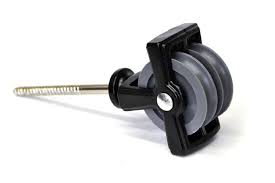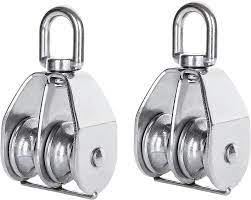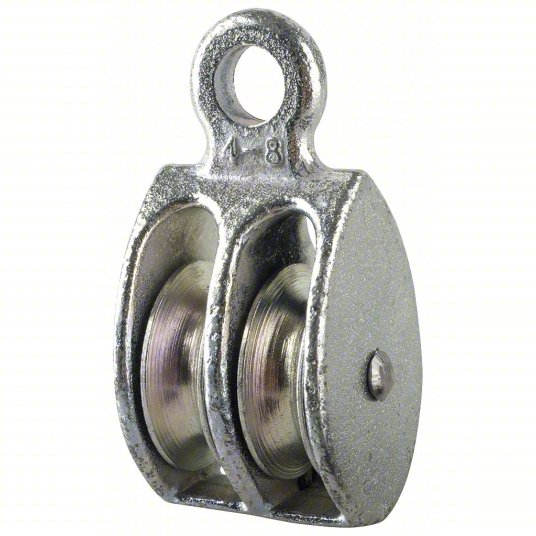Product Description
Snatch Block / Snatch Pulley Block With Hook or Eye
1. Material lifting equipment
2. High quality drop forged steel
3. Safety factor of snatch block: 4: 1
4. Hook (hs type) or eye (es type)
5. Capacity of snatch block: 0.5t~10t
6. Optional: Single wheel or double wheel
7. Sheave diameter: 75-350mm
8. Wire rope diameter: 8-28mm
9. Popular in Europe, Middle-East, North America, South America, & etc
Features of Snatch Block:
1. Durable powder coat finish
2. Heavy-duty permits to perform under extreme condition.
3. Rated loads is from 2MT to 50MT.
4. Safety factor: 4 times.
5.200% over load capacity test 1 by 1 before package.
6. Manufactured according to ISO9001 quality standard
7. CE and GS approved.
All our activities are accredited to ISO 9001 and based on delivering the highest quality possible, both in products and services, ensuring long-term benefits and optimum performance. Also we got the below certification: CE GS SUV, LR ABS ( anchors and anchor chains) Our rigging hardware is manufactured under exceptional quantity control and strictly adhered to the US, DIN, JIS, BS and AS standards.
About sample:
Cost with free If the quantity small, and the express charge account into buyer’s, after receiving the official order, the seller deducts it in first order’s
Please do not hesitate to contact us, should there be any questions or enquires.
—————-FAQ————–
Q1: Does your workshop have products in stock?
A1: Yes, we have. But we only have standard-sized products; if you need customized products, it will take some time to manufacture them.
Q2: Whether you can offer customized service?
A2: Yes, the working condition of every customer is different. All of our products can be customized depending on customers’ requirements. Please give us the information as straightforward as you can, so we can provide our best design to suit your demands.
Q3: How to confirm the working class of the crane?
A3: Please offer us the working environment, working duration, and frequency of the crane, and our engineer shall calculate it for you.
Q4: What kind of package for the hoist?
A4: Hoists and Electricals packed in wooden fumigation box. The main beams are covered by woven plastic cloth.
Q5: What kind of assistance can you offer with equipment installation?
A5: We have a professional installation team who has gone to many countries to assist with the installation. If you need us to send a technician to your factory, please let us know.
Q6: What payment terms can you accept?
A6: Our also supports L/C, D/A, D/P, T/T, Western Union, and MoneyGram payments. For example, FOB HangZhou, CIF, DDU, EX WORKS, etc.
| Type: | Pulley |
|---|---|
| Material: | Stainless Steel |
| Number of sheaves: | 1 |
| Control: | Manual |
| Color: | Blue |
| Application: | Double Beam Crane, Gantry Crane, Bridge Crane, Tower Crane, Single Grinder Crane, Lifting Platform, Small Crane |
| Samples: |
US$ 15/Piece
1 Piece(Min.Order) | |
|---|
| Customization: |
Available
| Customized Request |
|---|
How do double pulleys enhance the lifting and load-handling capabilities of machinery?
Double pulleys are a valuable component in machinery that enhances lifting and load-handling capabilities by providing mechanical advantage. Here’s a detailed explanation of how double pulleys achieve this:
1. Mechanical Advantage:
– Double pulleys utilize the concept of mechanical advantage to increase the lifting capacity and reduce the effort required to lift heavy loads. The mechanical advantage is achieved through the use of multiple sheaves or wheels within the pulley system.
2. Distribution of Load:
– With a double pulley setup, the load is distributed between two sections of the rope or cable. This distribution of load effectively reduces the strain on each section, allowing for a greater overall lifting capacity. By sharing the load, double pulleys enable the machinery to handle heavier loads than a single pulley system.
3. Increased Rope Length:
– Double pulleys also increase the effective length of the rope or cable used in the lifting mechanism. As the rope passes through the double pulley system, it travels a longer distance compared to a single pulley setup. The increased rope length translates into a greater range of movement and lifting capability for the machinery.
4. Directional Changes:
– Double pulleys offer the advantage of changing the direction of the applied force. By redirecting the pulling or lifting force, machinery can navigate complex paths or reach difficult-to-access areas. This directional flexibility enhances the versatility and maneuverability of the equipment when handling loads.
5. Smooth and Controlled Movement:
– Double pulleys facilitate smooth and controlled movement of the load. The multiple sheaves reduce friction and distribute the load evenly, resulting in a more stable and controlled lifting operation. This feature is particularly beneficial when precision and delicate handling of the load are required.
6. Versatility and Adaptability:
– Double pulleys can be incorporated into various types of machinery and equipment, offering versatility and adaptability. They can be integrated into cranes, hoists, winches, and other lifting systems. The ability to customize the configuration and arrangement of double pulleys allows machinery to be tailored to specific lifting requirements and load capacities.
7. Combination with Other Systems:
– Double pulleys can be combined with other mechanisms, such as gears or levers, to further enhance the lifting and load-handling capabilities of machinery. These combinations enable the amplification of force and provide additional mechanical advantages, allowing for the handling of even heavier loads.
Overall, double pulleys significantly enhance the lifting and load-handling capabilities of machinery by utilizing mechanical advantage, distributing the load, increasing rope length, enabling directional changes, facilitating smooth movement, and offering versatility in design and combination with other systems. The incorporation of double pulleys in machinery enhances efficiency, productivity, and safety in various industries and applications.
How does the arrangement of double pulleys affect their mechanical advantage?
The arrangement of double pulleys, also known as block and tackle systems or two-sheave pulleys, plays a crucial role in determining their mechanical advantage. Here is a detailed explanation of how the arrangement of double pulleys affects their mechanical advantage:
The mechanical advantage of a double pulley system is directly influenced by the number of supporting strands or “parts” of rope that are in tension. The arrangement of double pulleys refers to the configuration of pulley wheels and the path of the rope or cable within the system.
1. Fixed Pulley Arrangement:
– In a fixed pulley arrangement, one pulley is fixed to a stationary object, such as a beam or an anchor point, while the other pulley is attached to the load. The rope or cable forms a continuous loop, passing over the fixed pulley and then over the movable pulley attached to the load. This arrangement does not provide any mechanical advantage in terms of reducing the force required to lift the load. However, it changes the direction of the force, allowing for easier pulling or lifting in a different direction.
2. Movable Pulley Arrangement:
– In a movable pulley arrangement, both pulleys are attached to the load. The rope or cable forms a loop, with one end attached to a fixed point and the other end passing over the movable pulley and then attached to the load. This arrangement provides a mechanical advantage by dividing the load weight between two strands of rope. As a result, the force required to lift the load is halved compared to lifting it directly. The mechanical advantage in a movable pulley arrangement is expressed as “2:1”, indicating that the load is divided equally between the two supporting strands of rope.
3. Compound Pulley Arrangement:
– A compound pulley arrangement consists of multiple pulleys arranged in a combination of fixed and movable pulleys. The rope or cable passes over several pulleys, alternating between fixed and movable pulleys. This arrangement increases the mechanical advantage by increasing the number of supporting strands. For example, a compound pulley system with two fixed pulleys and one movable pulley provides a mechanical advantage of “3:1”, meaning the load is divided among three supporting strands of rope, reducing the force required to lift the load by one-third.
4. Multiple Blocks or Tackle Systems:
– Multiple blocks or tackle systems involve combining several double pulley arrangements to achieve even higher mechanical advantages. By incorporating additional pulleys and supporting strands, the mechanical advantage can be further increased. For instance, a system with two movable pulleys and two fixed pulleys arranged in a “4:1” configuration divides the load weight among four supporting strands, reducing the force required to lift the load by one-fourth.
It’s important to note that while the arrangement of double pulleys affects the mechanical advantage, it also impacts the distance the rope or cable must be pulled to move the load. As the mechanical advantage increases, the distance required to lift the load also increases. This trade-off between force and distance is inherent in pulley systems and should be considered when selecting the appropriate arrangement for a specific lifting task.
In summary, the arrangement of double pulleys, whether fixed, movable, compound, or multiple blocks, directly influences their mechanical advantage. The arrangement determines the number of supporting strands and the division of load weight, resulting in a reduction of the force required to lift the load. Selecting the appropriate arrangement is crucial to optimize the mechanical advantage based on the specific lifting requirements and constraints.
How does a double pulley assist in lifting and mechanical advantage?
A double pulley, also known as a block and tackle system or a two-sheave pulley, provides significant assistance in lifting heavy loads by utilizing mechanical advantage. Here is a detailed explanation of how a double pulley assists in lifting and creates a mechanical advantage:
A double pulley system consists of two pulley wheels mounted on a common axle or frame. The rope or cable that supports the load passes over both pulley wheels, creating multiple strands between the pulleys. The rope is attached to the load at one end and to an anchor point or a pulling mechanism at the other end.
The mechanical advantage provided by a double pulley arises from the redistribution of the load’s weight and the force required to lift it. When a force is applied to the free end of the rope, tension is generated along the rope’s length, including the sections passing over the pulley wheels.
The key advantage of a double pulley system is that it divides the load’s weight between the multiple strands of rope. Each strand carries a fraction of the load, reducing the force required to lift the entire weight. The mechanical advantage of a double pulley is directly proportional to the number of supporting strands or “parts” of rope that are in tension.
In a double pulley system, the mechanical advantage is typically expressed as the number of parts of rope supporting the load. For example, if a double pulley has two supporting strands, it is referred to as a “2:1” mechanical advantage system. This means that the load is divided equally between the two strands, resulting in a halving of the force required to lift the load compared to lifting it directly.
Furthermore, the mechanical advantage of a double pulley system can be increased by adding additional pulley wheels and increasing the number of supporting strands. For instance, a triple pulley system (three pulley wheels) would provide a “3:1” mechanical advantage, reducing the force required to lift the load by one-third.
It’s important to note that while a double pulley system reduces the force required for lifting, it increases the distance the rope must be pulled to move the load. This is due to the elongation of the rope caused by the multiple strands passing over the pulley wheels. The trade-off between force and distance is a fundamental characteristic of mechanical advantage in pulley systems.
In summary, a double pulley assists in lifting by redistributing the weight of the load among multiple strands of rope, thereby reducing the force required to lift the load. The mechanical advantage provided by a double pulley system is determined by the number of supporting strands, and it allows for the lifting of heavier loads with less effort compared to lifting the load directly.
editor by CX
2023-11-06




